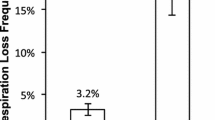Abstract
The occurrence of GC clusters inSaccharomyces spp. and related yeasts was examined to clarify their association with the stability of intact mitochondrial genome. Abundance of nonspecific or specific GC clusters in these species decreases with phylogenetic distance fromS. cerevisiae. Their number but not the number of replication origins correlates with the ability to form respiration-deficient mutants induced by ethidium bromide. This effect is not associated with the nuclear background since the cybrids having identical nuclei and mitochondria from different species gave similar results. In contrast to grand genomes, the presence of GC clusters in ρ- mutants does not play any role in ethidium bromide induced mtDNA loss. The most plausible explanation for mitotically lost petite mtDNA seems to be dilution during the distribution.
Similar content being viewed by others
References
Augustin S., Müller M.W., Schweyen R.J.: Reverse self-splicing of group II intron RNAin vitro.Nature343, 383–386 (1990).
Barnett J.A.: The taxonomy of the genusSaccharomycesMeyen ex.Reess: a short review for non-taxonomists.Yeast8, 1–23 (1992).
Butow R.A., Perlman P.S., Grossman L.I.: The unusualVAR1 gene of the yeast mitochondrial DNA.Science228, 1496–1501 (1985).
Chen X.J., Clark-Walker G.D.: The petite mutation in yeasts: 50 years on.Internat. Rev. Cytol.194, 197–238 (2000).
Defontaine A., Lecocq F.M., Hallet J.N.: A rapid miniprep method for the preparation of yeast mitochondrial DNA.Nucl. Acids Res.19, 185 (1991).
Dieckmann C.L., Gandy B.: Preferential recombination between GC clusters in yeast mitochondrial DNA.EMBO J.6, 4197–4203 (1987).
Dujon B.: Mitochondrial genetics and functions, pp. 505–635 in J. N. Strathern, E. W. Jones, J.R. Broach (Eds).The Molecular Biology of the Yeast Saccharomyces: Life Cycle and Inheritance. Cold Spring Harbor Laboratory Press, Cold Spring Harbor 1981.
Fangman W.L., Henley J.W., Brewer B.J.:RPO41-independent maintenance of ρ[su- mitochondrial DNA inSaccharomyces cerevisiae.Mol. Cell. Biol.10, 10–15 (1990).
Foury F., Rognati T., Lecrenier N., Purnelle B.: The complete sequence of the mitochondrial genome ofSaccharomyces cerevisiae.FEBS Lett.440, 325–331 (1998).
Fox T.D., Folley L.S., Mulero J.J., McMullin T.W., Thorsness P.E., Hedin L.O., Constanzo M.C.: Analysis and manipulation of yeast mitochondrial genes.Meth. Enzymol.194, 149–168 (1991).
Gaillard C., Strauss F., Bernardi G.: Excision sequences in the mitochondrial genome of yeast.Nature283, 218–220 (1980).
Goldring E.S., Grossman L.I., Krupnick D., Cryer D.R., Marmur J.: The petite mutation in yeast. Loss of mitochondrial deoxyribonucleic acid during induction of petites with ethidium bromide.J. Mol. Biol.52, 323–335 (1970).
Kolaczkowski M., Kolaczkowska A., Luczynski J., Witek S., Goffeau A.:In vivo characterization of the drug resistance profile of the major ABC transporters and other components of the yeast pleiotropic drug resistance network.Microb. Drug Res.4, 143–158 (1999).
Koll H., Schmidt C., Weisenberger G., Schmelzer C.: Three nuclear genes suppress a yeast mitochondrial splice defect when present in high copy number.Curr. Genet.12, 503–509 (1987).
Lecrenier N., Foury F.: New features of mitochondrial DNA replication system in yeast and manGene246 37–48 (2000).
Maleszka R.: Thein vivo effects of ethidium bromide on mitochondrial and ribosomal DNA inCandida parapsilosis.Yeast10, 1203–1210 (1994).
Maniatis T., Fritsch E.F., Sambrook J.:Molecular Cloning: a Laboratory Manual, Cold Spring Harbor Laboratory Press, Cold Spring Harbor 1982.
Miller D.L., Najarian D.R., Folse J.R., Martin N.C.: A mutation in thetRNAAsp gene from yeast mitochondria.J. Biol. Chem.256, 9774–9777 (1981).
Neidle S., Abraham Z.: Structural and sequence-dependent aspects of drug intercalation into nucleic acids.CRC Crit. Rev. Biochem.17, 73–121 (1984).
Piškur J.: Transmission of yeast mitochondrial loci to progeny is reduced when nearby intergenicori/rep sequences are deleted.Mol. Gen. Genet.214, 425–432 (1988).
Piškur J.: Inheritance of yeast mitochondrial genome.Plasmid31, 229–241 (1994).
Piškur J., Možina S.S., Groth C., Wager S., Pedersen M.B.: Structure and genetic stability of the mitochondrial genomes vary among yeast of the genusSaccharomyces.Internat. J. Syst. Bacteriol.48, 1015–1024 (1998).
Rayko E. Goursot R.: Amphimeric mitochondrial genomes of petite mutants of yeast—II. A model for amplification of amphimeric mitochondrial petite DNA.Curr. Genet.30, 135–144 (1996).
Rayko E., Goursot R.: Amphimeric mitochondrial genomes of petite mutants of yeast—III. Generation by linking two secondary-structure-dependent illegitimate recombination events.Curr. Genet.35, 14–22 (1999).
Schmitt M.E., Clayton D.A.: Conserved features of yeast and mammalian mitochondrial DNA replication.Curr. Opin. Genet.3, 769–774 (1993).
Šoltésová A., Špírek M., Horváth A., Sulo P.: Mitochondria—a tool for simple taxonomic identification of yeasts fromSaccharomyces cerevisiae complex.Folia Microbiol.45, 99–106 (2000).
Špírek M., Piškur J., Horváth A., Sulo P.: Functional co-operation betweenSaccharomyces cerevisiae nucleic and mitochondria from divergent yeast species.Curr. Genet.38, 202–207 (2000).
Sulo P., Špírek M., Šoltésová A., Marinoni G., Piškur J.: The efficiency of functional mitochondrial replacement inSaccharomyces species has vectorial nature,to be published (2002).
Sulo P., Groom K.R., Wise C., Steffen M., Martin N.C.: Successful transformation of yeast mitochondria withRPM1: an approach forin vivo studies of mitochondrial RNAase P RNA structure, function and biosynthesis.Nucl. Acids Res.23, 856–860 (1995).
Weiller G., Schueller C.M.E., Schweyen R.J.: Putative target sites for mobile G+C rich clusters in yeast mitochondrial DNA: single elements and tandem arrays.Mol. Gen. Genet.218, 272–283 (1989).
Weiller F.G., Bruckner H., Kim H.S., Pratje E., Schweyen R.J.: A GC clusters repeat is a hot spots for mit− macro-deletions in yeast mtDNA.Mol. Gen. Genet.226, 233–240 (1991).
de Zamaroczy M., Fangeron-Fonty G., Bernardi G.: Excision sequences in the mitochondrial genome of yeast.Genet21, 193–202 (1983).
de Zamaroczy M., Fangeron-Fonty G., Baldacci G., Goursot R., Bernardi G.: Theori sequences of the mitochondrial genome of a wild-type yeast strain: number, location, orientation and structure.Gene32, 439–457 (1984).
de Zamaroczy M., Bernardi G.: Sequence organization of the mitochondrial genome of yeast—a review.Gene37, 1–17 (1985).
de Zamaroczy M., Bernardi G.: The GC clusters of the mitochondrial genome of the yeast and their evolutionary origin.Gene41, 1–22 (1986).
Zinn K.A., Pohlman K.J., Perlman S.P., Butow R.A.:In vivo double-strand breaks occur at recombinogenic G+C rich sequences in the yeast mitochondrial genome.Proc. Nat. Acad. Sci. USA85, 2686–2689 (1988).
Author information
Authors and Affiliations
Corresponding author
Rights and permissions
About this article
Cite this article
Špírek, M., Šoltésová, A., Horváth, A. et al. GC clusters and the stability of mitochondrial genomes ofSaccharomyces cerevisiae and related yeasts. Folia Microbiol 47, 263–270 (2002). https://doi.org/10.1007/BF02817649
Received:
Revised:
Issue Date:
DOI: https://doi.org/10.1007/BF02817649




